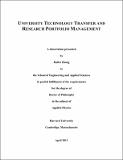| dc.description.abstract | University technology transfer is of critical importance to the U.S. innovation economy. Understanding the drivers of technology transfer efficiency will shed light on University research portfolio management. In this dissertation, survey data from The Association of University Technology Managers is analyzed in various aspects to offer a overall understanding of the technology transfer industry, which include University research fund composition, technology transfer office staffing, licenses executed to start-ups, small companies, and large companies, license income composition, legal fee expenditures, new patents applications, provisional patents, utility patents, and non USA patents, invention disclosures, U.S. patents issued, start-ups initiated, and annual averages of U.S. University technology transfer offices. Then, a two-stage technology transfer model based on Data Envelopment Analysis is proposed to address the limitation of the single-stage model. The two-stage model provides the capacity to evaluate the efficiencies of university research and technology transfer office separately and also as a whole, offering better insights for university technology transfer management. Year to year productivity changes are also measured using Malmquist Index. It is found the productivity growth has stemmed primarily from a growth in commercialization by all universities rather than a catching up by the inefficient universities. Finally, technology transfer efficiency and academic reputation is studied for the first time. Counter intuitively, they are not correlated. To further understand University research portfolio management, Modern Portfolio Theory is applied for the first time in this field. University disciplines are categorized into three major disciplines: engineering, physical and mathematical sciences, and biological and life sciences. The risk and return of technology transfer are defined and research portfolio risk-return curve are solved. Then correlation between portfolio balance and technology transfer efficiency are studied. It is found that a balanced portfolio is correlated to technology transfer efficiency, which means Universities can structure its research portfolio to increase technology transfer efficiency. | en_US |


